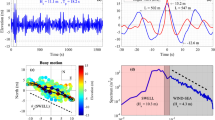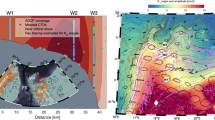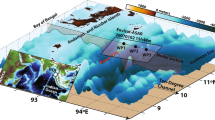Abstract
Ocean waves are a principal agent in the deterioration and ultimate breakup of Antarctic tabular icebergs in the Southern Ocean. We present here some preliminary results from a recent (January 1982) field season on board HMS Endurance during which two tabular icebergs of very different shape were studied in detail. The data augment the results of a similar season of work1,2 which took place in 1981 near the South Sandwich and South Orkney Islands. Instruments to measure rigid body motions and strain gauges to determine wave-induced bending were deployed at the surface centre of the two icebergs visited, while a Waverider buoy simultaneously monitored the ocean wave-energy spectrum. The precise underwater shape of each iceberg was determined by flying a 60-MHz radar (developed for use over land ice)3,4 in a grid pattern across the surface of the iceberg. By this means a complete three-dimensional picture of the iceberg could be inferred. The results show that icebergs tend to act as low-pass filters and inhibit short period waves. Furthermore, they selectively resonate at certain wave periods; the strain data, in particular, indicate unexpectedly large flexure which cannot be explained by simple bending alone. Finally, the geometry of icebergs can be such as to render them unstable and liable to turn over.
This is a preview of subscription content, access via your institution
Access options
Subscribe to this journal
Receive 51 print issues and online access
$199.00 per year
only $3.90 per issue
Buy this article
- Purchase on Springer Link
- Instant access to full article PDF
Prices may be subject to local taxes which are calculated during checkout
Similar content being viewed by others
References
Kristensen, M., Orheim, O. & Wadhams, P. Polar Rec. 20, 445–457 (1981).
Orheim, O., Wadhams, P. & Kristensen, M. Ann. Glaciol. 3, 357–358 (1982): Iceberg Res. 1, 10–15 (1982).
Evans, S. & Smith, B. M. E. J. scient. Instrum. 2, 131–136 (1969).
Robin, G., de Q. Evans, S. & Bailey, J. T. Phil. Trans. R. Soc. A265, 437–505 (1969).
Jaeger, J. C. Elasticity, Fracture and Flow with Engineering and Geological Applications (Methuen, New York, 1956).
Squire, V. A. J. Glaciol. 29, 425–431 (1979).
Moore, S. C. & Wadhams, P. Tech. Rep. No. 81–2 (Scott Polar Research Institute, Cambridge, 1981).
Squire, V. A. & Martin, S. Sci. Rep. No. 18 (School of Oceanography, University of Washington, Seattle, 1980).
Lewis, E. V. Principles of Naval Architecture (ed. Comstock, J. P.) 607–717 (The Society of Naval Architects and Marine Engineers, 1967).
Weeks, W. F. & Mellor, M. Iceberg Utilization, Proc. of the First int. Conf., Ames, Iowa, 45–98 (Pergamon, New York, 1978).
Foldvik, A., Gammelsrod, T. & Gjessing, Y. Ann. Glaciol. 1, 29–30 (1980).
Author information
Authors and Affiliations
Rights and permissions
About this article
Cite this article
Kristensen, M., Squire, V. & Moore, S. Tabular icebergs in ocean waves. Nature 297, 669–671 (1982). https://doi.org/10.1038/297669a0
Received:
Accepted:
Issue Date:
DOI: https://doi.org/10.1038/297669a0
Comments
By submitting a comment you agree to abide by our Terms and Community Guidelines. If you find something abusive or that does not comply with our terms or guidelines please flag it as inappropriate.



